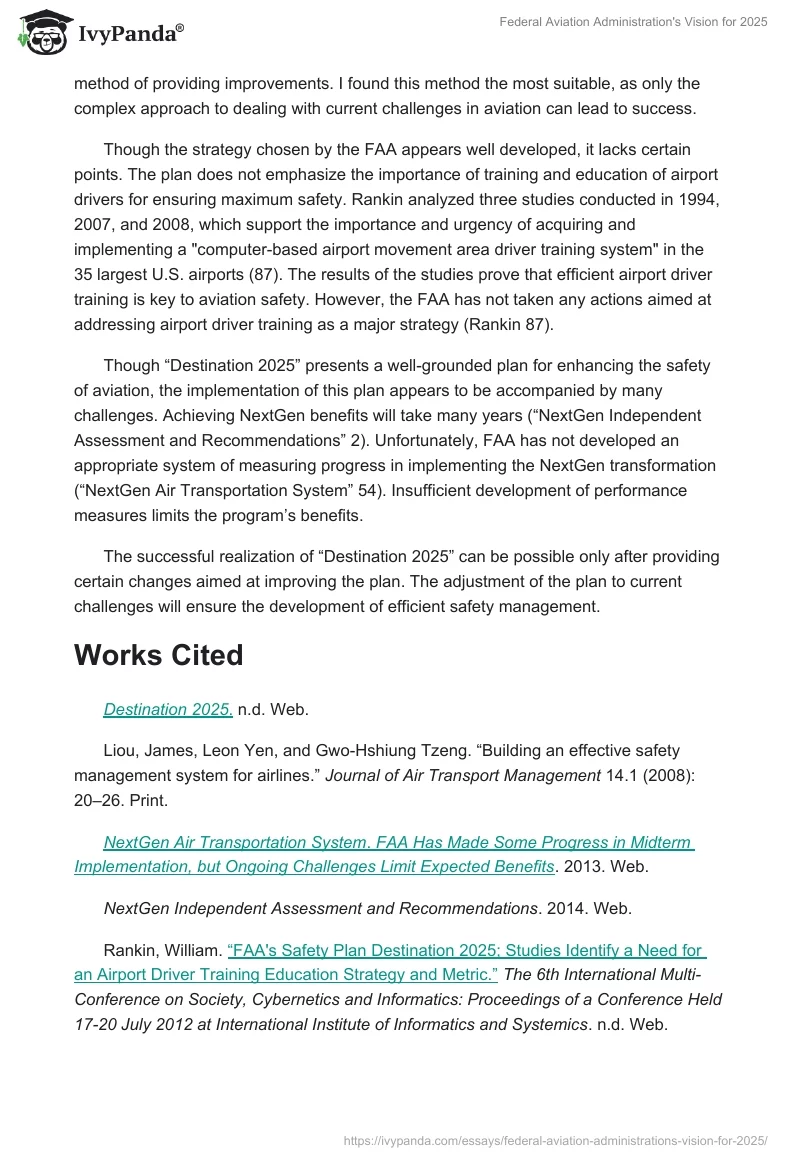Federal Aviation Administration has expressed its vision of goals that are supposed to be achieved by 2025 in “Destination 2025”. Though the overall strategy of transformation is well-developed, further actions should be taken to improve the plan and provide a successful realization of the strategy aimed at promoting the safety of aviation.
FAA has been working on providing maximum safety of the aviation system for decades. The efficient work brought great results, as the number of fatal accidents has decreased drastically. FAA is looking forward to improving the system, ensuring the safety of air carriages, and enable bigger aviation capacity. The strategy for achieving these goals includes employing the Next Generation Air Transportation System (NextGen) (“Destination 2025” 1). NextGen is aimed at transforming the air traffic control system and providing the extension of passenger and cargo capacity. Besides sustained aviation growth, NextGen is supposed to develop “environmental protection” that reduces the impact of aviation on climate change (Wuebbles, Gupta, and Ko 157).
Cooperation with international partners, including the International Civil Aviation Organization, is also mentioned as an important part of the process aimed at improving global aviation safety (“Destination 2025” 2). Safety Management Systems (SMS) are regarded as essential to providing the expected progress. SMS are used to deal with the risks related to human factors issues in aviation safety management (Liou, Yen, and Tzeng 20). FAA emphasizes the importance of creating a convenient workplace for the people involved in providing aviation services.
In my opinion, the plan presented by the FAA appears to be well-grounded and can bring great results. The strategy described in “Destination 2025” mostly relies on NextGen. I think the main advantage of NextGen transformation is its orientation toward covering all areas related to the functioning of aviation. The concentration on one distinctive aspect inevitably leads to a lack of attention to other aspects. Such a situation results in the evolvement of new problems. NextGen does not focus on one particular aspect that needs to be improved. Instead, it is based on the comprehensive method of providing improvements. I found this method the most suitable, as only the complex approach to dealing with current challenges in aviation can lead to success.
Though the strategy chosen by the FAA appears well developed, it lacks certain points. The plan does not emphasize the importance of training and education of airport drivers for ensuring maximum safety. Rankin analyzed three studies conducted in 1994, 2007, and 2008, which support the importance and urgency of acquiring and implementing a “computer-based airport movement area driver training system” in the 35 largest U.S. airports (87). The results of the studies prove that efficient airport driver training is key to aviation safety. However, the FAA has not taken any actions aimed at addressing airport driver training as a major strategy (Rankin 87).
Though “Destination 2025” presents a well-grounded plan for enhancing the safety of aviation, the implementation of this plan appears to be accompanied by many challenges. Achieving NextGen benefits will take many years (“NextGen Independent Assessment and Recommendations” 2). Unfortunately, FAA has not developed an appropriate system of measuring progress in implementing the NextGen transformation (“NextGen Air Transportation System” 54). Insufficient development of performance measures limits the program’s benefits.
The successful realization of “Destination 2025” can be possible only after providing certain changes aimed at improving the plan. The adjustment of the plan to current challenges will ensure the development of efficient safety management.
Works Cited
Destination 2025. n.d. Web.
Liou, James, Leon Yen, and Gwo-Hshiung Tzeng. “Building an effective safety management system for airlines.” Journal of Air Transport Management 14.1 (2008): 20–26. Print.
NextGen Independent Assessment and Recommendations. 2014. Web.
Rankin, William. “FAA’s Safety Plan Destination 2025; Studies Identify a Need for an Airport Driver Training Education Strategy and Metric.”The 6th International Multi-Conference on Society, Cybernetics and Informatics: Proceedings of a Conference Held 17-20 July 2012 at International Institute of Informatics and Systemics. n.d. Web.
Wuebbles, Don, Mohan Gupta, and Malcolm Ko. “Evaluating the Impacts of Aviation on Climate Change.” Eos, Transactions, American Geophysical Union 88.14 (2007): 157-160. Print.


